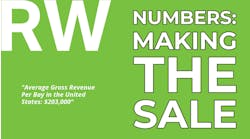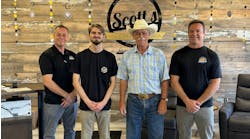SHOP STATS: OK Tire Locations: 2 in Fargo, N.D. CEO: Adam Mueller Average Monthly Car Count: 900
Staff Size at Main Location: 25
SHOP STATS: Cardinal Plaza Shell Location: Springfield, Va. Operator: Scott Brown
Average Monthly Car Count: 1,500 Staff Size: 25 Shop Size: 2,500 square feet Annual Revenue: $4.2 million
At some point in your career, your shop is going to hit the peak amount of customers it can handle. But how do you determine if your shop is really at capacity or not? In other words, is it time to invest in an additional location, or can an adjustment in the shop’s layout or procedures make the world of difference?
After 60 years in the same location, OK Tire in Fargo, N.D., officially determined they’d used up all of their resources and space, and after consulting its employees, the shop decided to invest in an additional location just five miles across town. But for Scott Brown, owner of Cardinal Plaza Shell in Springfield, Va., he’s made his space work for him. Since his father opened up the shop in 1969, the town has grown all around it; it was the dream location for any shop owner. And Brown wasn’t quite ready to devote his time to two different locations. Since then, he’s been able to make his “small but mighty” 2,500-square-foot shop work, pushing out 1,500 cars per month with an annual revenue of $4.2 million [Note: Brown finally pulled the trigger and a second location is in the works after over 50 years in a one-shop operation].
Making the choice to add a new building is a difficult one, and it may or may not be necessary. Here are four questions to ask yourself to determine if you’ve maxed out your current building’s location or if there’s a way to make it work.
Is an expansion on the facility a possibility?
Another building may not be necessary. The easiest solution could be to add on to your current shop. However, that may or may not be an option.
For OK Tire, the Fargo location had been there for over 60 years and had three to four additions over that time. And, with being in an older location, the city developed around it and there was no more room on their lot to physically expand. They didn’t want to move from their current Fargo location, but they knew they needed extra space for that particular customer base.
“There wasn’t space to expand, but there was a customer need to expand,” says Mike Swab, manager of one of OK Tire’s Fargo, N.D. locations.
For Cardinal Plaza Shell, Brown determined a few renovations would add more space. Brown says the shop used to just have four lifts, and a store room for parts was off to the side. With so many auto parts shops near their operation, Brown was able to get rid of the store room completely and go with in-time delivery of parts. And with this decision, the shop was able to add in two more bays.
Is the current space being used in the best way possible?
When considering if your shop is really maxed out, shop owners need to look at how they are utilizing their location.
2,500 square feet, especially with 25 employees, is not a lot of space to work with. However, Brown was able to make the better use of his space when things got tight. One way he did this was through a tip he got from his 20 Group: spaghetti diagrams. This diagram, Brown learned, is a visual representation that uses a continuous flow line tracing the path of an item or activity through an entire process. With this, the diagram helps to identify redundancies in the workflow and opportunities to expedite process flow; in other words, it ensures everything is located in the exact right spot for maximum efficiency. Along with this diagram, Brown also has his techs work outside in the parking lot on jobs that don’t require a lift, making way for more cars without having to stretch out the shop’s walls.
Have we asked for staff feedback?
It’s always good to get a second opinion; it ensures you didn’t skip a beat and you’ve left every rock unturned. Both Swab and Brown say getting your team’s opinion can help decide if the shop’s truly maxed out, or if there are other opportunities to look into. In Brown’s operation, in fact, most of the shop’s efficiency ideas have come from his own staff. For example, one of his employees recommended using a text-to-pay system to speed through the checkout process, and, according to Brown, it’s changed the shop’s workflow in an extremely positive way; drop-off and pick-up times have cut down from a lot of time spent to no time spent at all.
Are we actually at capacity?
One of the main issues OK Tire was having was long customer wait times; Swab says the shop had more cars than they had bays. They needed to determine if they could increase efficiency in customer wait times, asking themselves, do we have long wait times because we are taking too long on the job, or because we just have that many cars? To figure this out, OK Tire used a combination of dollars per bay, amount a hoist was making per hour per bay, and customer wait times. Swab says the shop used an excel spreadsheet to plug in these numbers from daily records, and comparing the different trends over seasons. Swab also timed his techs to get their individual efficiency percentages. If they’re meeting the mark on a single job, it indicates it’s the amount of cars that are causing delays, which happened to be the case.
“If you aren’t seeing any increase in trends, it’s a good indication that efficiency has hit its limit,” Swab says.
Brown utilized the same concept, only he took a different approach to ensure that not one rack was ever empty at his shop.
What’s helped Brown calculate if the shop is being as efficient as possible is using ATI’s Win Number, which looks at your shop’s efficiency and capacity based on your technicians and overall time All an operator has to do is plug in the business's financial and operational numbers, like labor rate, hours per ticket, and productivity, and the sheet’s algorithm takes care of the rest. While Brown uses the win number for each of his employees, owners can also apply it to their entire shop. It’s all about what works best for them. For his shop, Brown is now between 110 and 115 percent efficiency, with his technicians working at around 85 percent efficiency.



